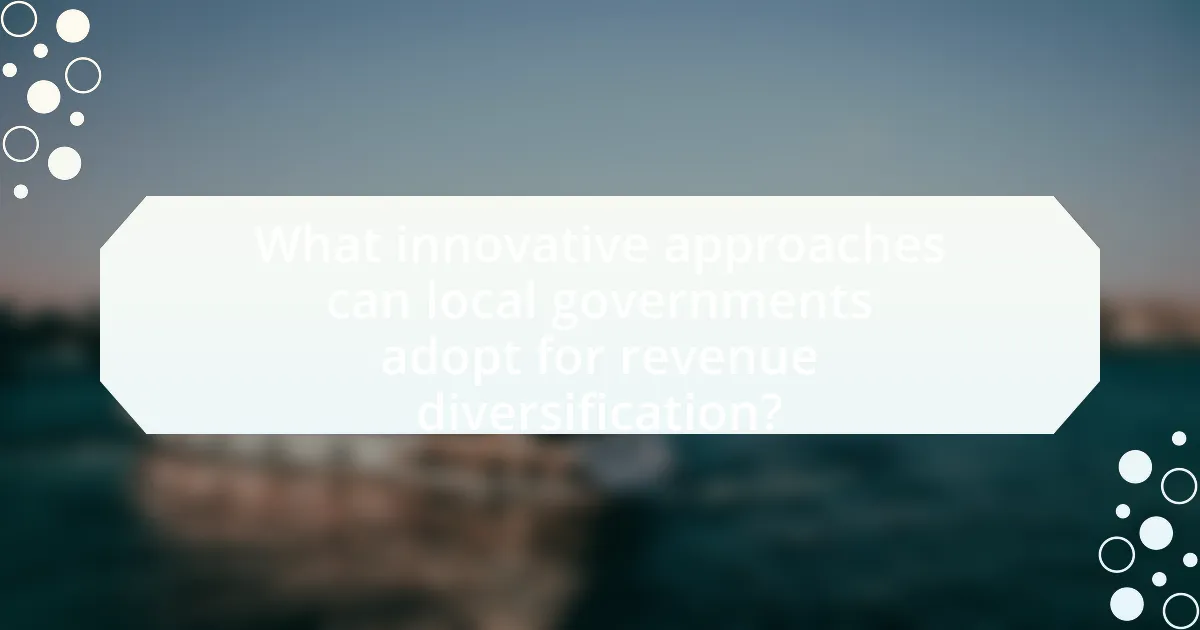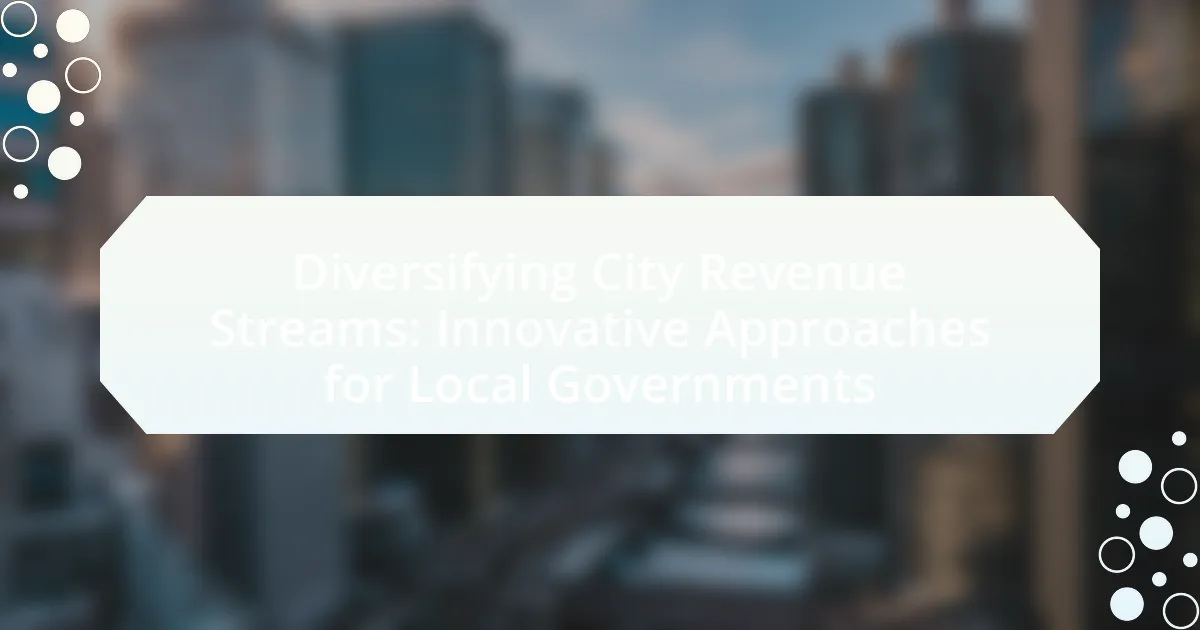The article focuses on the challenges local governments face when relying on traditional city revenue streams, such as property and sales taxes, which are vulnerable to economic fluctuations and can create inequitable tax burdens. It emphasizes the importance of diversifying revenue sources to enhance financial stability and resilience against economic downturns. Key strategies discussed include implementing public-private partnerships, leveraging technology for smart city initiatives, and exploring alternative funding sources like grants and social impact bonds. The article also highlights best practices for assessing revenue diversification efforts and the potential benefits of a diversified revenue model for local governments.

What are the challenges of relying on traditional city revenue streams?
Relying on traditional city revenue streams presents several challenges, including economic volatility, limited growth potential, and inequitable tax burdens. Economic downturns can significantly reduce revenue from property taxes and sales taxes, as seen during the 2008 financial crisis when many cities faced budget shortfalls due to decreased consumer spending and property values. Additionally, traditional revenue sources often fail to keep pace with rising costs and population growth, limiting the ability of cities to invest in infrastructure and services. Furthermore, reliance on property taxes can disproportionately affect lower-income residents, leading to inequitable financial burdens. These challenges necessitate the exploration of alternative revenue sources to ensure sustainable city funding.
How do economic fluctuations impact city revenue?
Economic fluctuations significantly impact city revenue by altering tax collections and reducing funding from various sources. During economic downturns, cities often experience decreased sales tax revenue as consumer spending declines, leading to budget shortfalls. For instance, the National League of Cities reported that cities faced a 20% drop in revenue during the 2008 financial crisis, highlighting the direct correlation between economic conditions and municipal income. Conversely, during periods of economic growth, cities may see increased property tax revenues and higher sales tax collections, which can enhance their financial stability and ability to invest in public services. Thus, the cyclical nature of economic conditions directly influences the financial health of local governments.
What specific revenue sources are most affected by economic downturns?
Specific revenue sources most affected by economic downturns include sales tax, property tax, and income tax. During economic downturns, consumer spending declines, leading to reduced sales tax revenue for local governments. Additionally, property values often decrease, resulting in lower property tax collections. Income tax revenues also suffer as unemployment rises and wages stagnate, further straining local government budgets. Historical data from the 2008 financial crisis illustrates these trends, where cities experienced significant drops in these revenue streams, highlighting their vulnerability during economic recessions.
How can cities mitigate the risks associated with these fluctuations?
Cities can mitigate the risks associated with revenue fluctuations by diversifying their revenue streams. This approach reduces dependency on a single source of income, such as property taxes or sales taxes, which can be volatile. For instance, cities can implement user fees for services, develop public-private partnerships, and invest in sustainable tourism initiatives. Research indicates that cities with diversified revenue sources experience greater financial stability; for example, a study by the Urban Institute found that cities with multiple revenue streams were less affected by economic downturns. By adopting these strategies, cities can create a more resilient financial framework that withstands economic fluctuations.
Why is diversifying revenue streams important for local governments?
Diversifying revenue streams is important for local governments because it enhances financial stability and resilience against economic fluctuations. By relying on multiple sources of income, such as property taxes, sales taxes, grants, and fees, local governments can mitigate the risks associated with downturns in any single revenue source. For instance, during economic recessions, property tax revenues may decline, but if a local government has diversified into tourism or service fees, it can maintain essential services and infrastructure funding. This approach not only ensures consistent funding for public services but also fosters economic growth by attracting investments and creating jobs, as evidenced by cities that have successfully implemented diverse revenue strategies, leading to improved fiscal health and community development.
What are the potential benefits of a diversified revenue model?
A diversified revenue model offers multiple benefits, including increased financial stability and reduced reliance on a single income source. By generating revenue from various streams, local governments can mitigate risks associated with economic downturns or fluctuations in specific sectors. For instance, cities that diversify their revenue through taxes, fees, grants, and public-private partnerships can better withstand budget shortfalls. Research indicates that municipalities with diversified revenue sources experience less volatility in funding, allowing for more consistent public service delivery and investment in community projects. This approach not only enhances fiscal resilience but also fosters innovation and adaptability in local governance.
How does diversification enhance financial stability for cities?
Diversification enhances financial stability for cities by spreading revenue sources across various sectors, reducing reliance on a single income stream. This approach mitigates risks associated with economic downturns, as cities with diverse revenue streams, such as property taxes, sales taxes, tourism, and business licenses, are less vulnerable to fluctuations in any one sector. For instance, during the 2008 financial crisis, cities with diversified economies experienced less severe budget shortfalls compared to those heavily dependent on a single industry. This evidence demonstrates that a varied revenue base allows cities to maintain essential services and invest in community development, ultimately fostering long-term financial resilience.

What innovative approaches can local governments adopt for revenue diversification?
Local governments can adopt innovative approaches for revenue diversification by implementing public-private partnerships (PPPs) to leverage private investment in community projects. These partnerships can enhance infrastructure development and service delivery while generating additional revenue streams through shared profits and reduced public expenditure. For instance, cities like San Diego have successfully utilized PPPs for park development, resulting in improved facilities and increased local revenue through enhanced tourism and community engagement. Additionally, local governments can explore alternative financing mechanisms such as social impact bonds, which attract private funding for social programs with returns tied to measurable outcomes, thereby diversifying their revenue sources while addressing community needs.
How can cities leverage technology to create new revenue streams?
Cities can leverage technology to create new revenue streams by implementing smart city solutions that enhance efficiency and generate income. For instance, cities can utilize data analytics to optimize public services, leading to cost savings that can be redirected into revenue-generating projects. Additionally, cities can adopt digital platforms for e-commerce and local business support, which can increase sales tax revenue. A study by the McKinsey Global Institute found that smart city technologies could generate up to $1.5 trillion in economic value annually by improving urban efficiency and productivity. Furthermore, cities can explore partnerships with tech companies to develop innovative services, such as smart parking systems that charge users dynamically based on demand, thus creating a new revenue source.
What role do smart city initiatives play in revenue generation?
Smart city initiatives significantly enhance revenue generation for local governments by leveraging technology to improve efficiency and attract investment. These initiatives often involve the implementation of data-driven solutions that optimize city services, reduce operational costs, and create new revenue streams through innovative applications. For instance, cities that adopt smart infrastructure, such as intelligent transportation systems, can reduce traffic congestion, leading to lower costs for public services and increased economic activity. According to a report by McKinsey, smart city technologies could generate up to $1.5 trillion in economic value globally by 2025, demonstrating their potential to boost local economies and enhance tax revenues. Additionally, smart cities can attract businesses and tourism through improved quality of life and enhanced urban environments, further contributing to revenue growth.
How can data analytics improve revenue collection and management?
Data analytics can significantly enhance revenue collection and management by enabling local governments to identify trends, optimize resource allocation, and improve decision-making processes. By analyzing historical data on tax collections, spending patterns, and economic indicators, municipalities can forecast revenue more accurately and identify potential areas for growth. For instance, a study by the Urban Institute found that cities employing data analytics saw a 10-15% increase in tax compliance rates due to targeted outreach and improved taxpayer services. This data-driven approach allows local governments to streamline operations, reduce costs, and ultimately increase overall revenue efficiency.
What alternative funding sources can cities explore?
Cities can explore alternative funding sources such as public-private partnerships, grants from foundations, crowdfunding, and social impact bonds. Public-private partnerships allow cities to leverage private investment for public projects, enhancing infrastructure without solely relying on taxpayer funds. Grants from foundations provide financial support for specific initiatives, often aimed at community development or sustainability. Crowdfunding enables cities to engage citizens directly in funding projects, fostering community involvement and investment. Social impact bonds offer a way to fund social programs by attracting private investment, with returns based on the achievement of specific outcomes. These funding sources can diversify revenue streams and reduce reliance on traditional taxation methods.
How can public-private partnerships enhance city revenue?
Public-private partnerships (PPPs) can enhance city revenue by leveraging private investment to fund public projects, thereby reducing the financial burden on local governments. These partnerships allow cities to access additional resources for infrastructure development, such as roads, bridges, and public transportation systems, which can lead to increased economic activity and higher tax revenues. For instance, a study by the National Council for Public-Private Partnerships indicates that successful PPPs can generate significant savings and revenue growth, with some projects yielding returns of up to 15% on investment. By collaborating with private entities, cities can also improve service delivery and efficiency, attracting more businesses and residents, which further contributes to revenue growth through property taxes and sales taxes.
What are the benefits of implementing local taxes or fees?
Implementing local taxes or fees provides municipalities with a reliable source of revenue that can be used to fund essential services and infrastructure. Local taxes and fees enable governments to address specific community needs, such as public safety, education, and transportation, thereby enhancing the quality of life for residents. For instance, according to the National League of Cities, local governments rely on property taxes, sales taxes, and user fees to generate approximately 40% of their total revenue, which underscores the importance of these financial mechanisms in maintaining local services. Additionally, local taxes can be tailored to reflect the unique economic conditions and priorities of a community, allowing for more effective resource allocation and fiscal sustainability.

What best practices should local governments follow when diversifying revenue streams?
Local governments should adopt a multi-faceted approach to diversify revenue streams effectively. This includes implementing user fees for services, enhancing property tax assessments, and exploring public-private partnerships. For instance, cities like San Diego have successfully increased revenue by introducing fees for specific services, which can generate significant funds while ensuring that users contribute to the costs of the services they utilize. Additionally, improving property tax assessments can lead to more accurate revenue collection, as demonstrated by cities that have updated their assessment methods to reflect current market values. Public-private partnerships can also provide innovative funding solutions, as seen in various urban development projects where private investment complements public funding, leading to enhanced infrastructure and services. These practices not only broaden the revenue base but also promote fiscal sustainability and community engagement.
How can cities effectively assess their revenue diversification strategies?
Cities can effectively assess their revenue diversification strategies by implementing a comprehensive evaluation framework that includes data analysis, stakeholder engagement, and benchmarking against best practices. This framework allows cities to analyze revenue sources, identify dependency risks, and measure the effectiveness of various revenue streams. For instance, cities can utilize financial performance metrics, such as revenue growth rates and elasticity of demand for services, to evaluate how well diversified their revenue sources are. Additionally, engaging stakeholders, including community members and local businesses, provides insights into the perceived value and sustainability of different revenue strategies. Benchmarking against similar municipalities can reveal successful practices and highlight areas for improvement, ensuring that cities remain competitive and resilient in their revenue generation efforts.
What metrics should be used to evaluate the success of new revenue streams?
To evaluate the success of new revenue streams, local governments should use metrics such as revenue growth, cost-to-revenue ratio, customer acquisition cost, and return on investment (ROI). Revenue growth measures the increase in income generated from new streams over time, indicating their effectiveness. The cost-to-revenue ratio assesses the expenses incurred relative to the revenue generated, helping to determine profitability. Customer acquisition cost evaluates the resources spent to attract new customers, which is crucial for understanding the sustainability of revenue streams. ROI quantifies the financial return on investments made in these new initiatives, providing a clear picture of their overall success. These metrics collectively offer a comprehensive framework for assessing the viability and impact of diversified revenue sources in local government contexts.
How can community engagement improve revenue diversification efforts?
Community engagement can improve revenue diversification efforts by fostering stronger relationships between local governments and residents, leading to increased support for new initiatives. Engaged communities are more likely to participate in local programs, contribute to funding efforts, and support local businesses, which can enhance economic activity. For example, a study by the National League of Cities found that cities with high levels of community engagement saw a 20% increase in participation in local funding initiatives. This participation can directly translate into diversified revenue streams through increased local taxes, fees, and contributions to community projects.
What common pitfalls should local governments avoid in revenue diversification?
Local governments should avoid over-reliance on a single revenue source when diversifying their revenue streams. This pitfall can lead to financial instability, as fluctuations in that source can significantly impact overall revenue. For instance, municipalities that depend heavily on property taxes may face budget shortfalls during economic downturns when property values decline. Additionally, local governments should be cautious of implementing complex tax structures that can confuse taxpayers and increase administrative costs. Simplifying tax codes can enhance compliance and reduce costs. Furthermore, failing to engage with the community during the revenue diversification process can result in public pushback and decreased trust in local government. Engaging stakeholders ensures that new revenue initiatives align with community needs and values.
How can cities ensure compliance with regulations while diversifying revenue?
Cities can ensure compliance with regulations while diversifying revenue by implementing technology-driven solutions that streamline regulatory processes and enhance transparency. For instance, cities can adopt digital platforms for permitting and licensing, which not only facilitate compliance tracking but also create new revenue streams through service fees. A study by the National League of Cities found that municipalities utilizing e-permitting systems reported a 30% increase in efficiency and a corresponding rise in revenue from application fees. By integrating compliance measures into revenue-generating activities, cities can effectively balance regulatory adherence with financial growth.
What strategies can prevent over-reliance on a single revenue source?
To prevent over-reliance on a single revenue source, local governments can implement strategies such as diversifying revenue streams through the introduction of new taxes, fees, and grants. For instance, cities can explore options like property taxes, sales taxes, and user fees for services, which can collectively reduce dependence on a single source. Additionally, engaging in public-private partnerships can create alternative funding avenues, allowing for investment in infrastructure and services without solely relying on municipal budgets. Evidence from various municipalities shows that cities with diversified revenue sources are more resilient during economic downturns, as they can better absorb shocks from fluctuations in any one revenue stream.
What practical steps can local governments take to implement innovative revenue strategies?
Local governments can implement innovative revenue strategies by exploring public-private partnerships, which leverage private investment for public projects. These partnerships can enhance infrastructure development and service delivery while generating new revenue streams. For instance, cities like San Diego have successfully utilized public-private partnerships to fund major infrastructure projects, resulting in improved services and increased economic activity. Additionally, local governments can adopt technology-driven solutions, such as implementing smart city initiatives that optimize resource management and reduce operational costs, ultimately leading to increased revenue. Research indicates that cities employing smart technologies can see a return on investment through enhanced efficiency and service delivery. Furthermore, diversifying funding sources through grants, impact fees, and local taxes on emerging industries, such as cannabis or renewable energy, can provide sustainable revenue options. For example, Colorado has generated significant tax revenue from legalized cannabis, which has been reinvested into community programs.

Leave a Reply